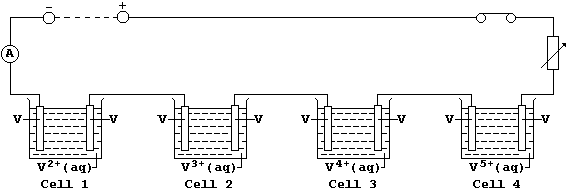METALS: VANADIUM
Vanadium, a relatively rare element in the Earth's crust (0.01%), is
usually found as a sulfide (e.g., in the ore patronite). This
transition metal, which has a high melting point (1890°C) and a high
density (6.09 g cm-³), forms coloured compounds in several oxidation
states [e.g., V(II), V(III), V(IV), and V(V)]. Although the metal is
used to manufacture relatively small quantities of 'vanadium' steels
that have high tensile strengths, the element's particular importance
in industrial chemistry centres on the use of vanadium(V) oxide as a
catalyst for the oxidation of sulfur dioxide to sulfur trioxide (a
key step in the manufacture of sulfuric acid).
[.. Ca > Na > Mg > Al > V > Zn > Fe > Sn > Pb > (H) > Cu > Hg > Ag ..]
1. The extraction of vanadium from its various ores is very complex,
but the final process involves chemical reduction of vanadium(V) oxide
with molten calcium. Construct the symbol equation for this reaction.
_______________________________________________________________________
[2]
Calcium is preferred to carbon as the reducing agent, for two reasons:
one, a lower furnace temperature can be used because the redox reaction
is more exothermic; and two, carbon forms compounds with vanadium at
high temperatures. Suggest one disadvantage in the use of calcium as a
reducing agent. _______________________________________________________
[1]
2. Shown below is a diagram of four electrolytic cells connected in
series; nominally, each cell contained the vanadium ions as stated.

[Q = n × z × F and Q = I × t, where: Q, measured in coulombs (C), is
the quantity of electricity; n is the number of moles of substance
evolved at the electrode; z is the charge on the ion; F is a constant,
with a value of 96500 C mol-¹; I, measured in amps (A), is the current;
and t, measured in seconds (s), is the time.]
(a) In 60 minutes, 1.275 g of vanadium were deposited at the cathode of
cell 1. Determine the current (I) that flowed in this circuit - as
follows.
Calculate the number of moles (n) of vanadium deposited at the cathode
of cell 1. ____________________________________________________________
Calculate the quantity of electricity (Q) required to deposit this
number of moles. ______________________________________________________
And finally, calculate the current (I) that flowed in the circuit. ____
_______________________________________________________________________
[6]
(b) Complete the Table below, calculating the values where appropriate.
|
Cell 1 |
Cell 2 |
Cell 3 |
Cell 4 |
Charge on vanadium ion |
2+ |
3+ |
4+ |
5+ |
Vanadium deposited (n) / mol |
|
|
|
|
[3]
3. The radioactive isotope vanadium-49 has a half-life of 330 days. A
sample tube, sealed in a lead-lined chamber for 1320 days, was found to
contain 0.125 g of this isotope.
(a) Calculate the mass of the isotope that was present originally. ____
_______________________________________________________________________
_______________________________________________________________________
[3]
(b) Using the data calculated above, plot a graph of mass of isotope
(vertical axis) against the number of half-lives elapsed, and then draw
the best curve through the points.
_ _ _ _ _ _ _ _ _ _ _ _ _ _ _ _ _ _ _ _ _ _ _ _ _ _
_|_|_|_|_|_|_|_|_|_|_|_|_|_|_|_|_|_|_|_|_|_|_|_|_|_|_|
|_|_|_|_|_|_|_|_|_|_|_|_|_|_|_|_|_|_|_|_|_|_|_|_|_|_|
_|_|_|_|_|_|_|_|_|_|_|_|_|_|_|_|_|_|_|_|_|_|_|_|_|_|_|
|_|_|_|_|_|_|_|_|_|_|_|_|_|_|_|_|_|_|_|_|_|_|_|_|_|_|
_|_|_|_|_|_|_|_|_|_|_|_|_|_|_|_|_|_|_|_|_|_|_|_|_|_|_|
|_|_|_|_|_|_|_|_|_|_|_|_|_|_|_|_|_|_|_|_|_|_|_|_|_|_|
_|_|_|_|_|_|_|_|_|_|_|_|_|_|_|_|_|_|_|_|_|_|_|_|_|_|_|
|_|_|_|_|_|_|_|_|_|_|_|_|_|_|_|_|_|_|_|_|_|_|_|_|_|_|
_|_|_|_|_|_|_|_|_|_|_|_|_|_|_|_|_|_|_|_|_|_|_|_|_|_|_|
|_|_|_|_|_|_|_|_|_|_|_|_|_|_|_|_|_|_|_|_|_|_|_|_|_|_|
_|_|_|_|_|_|_|_|_|_|_|_|_|_|_|_|_|_|_|_|_|_|_|_|_|_|_|
|_|_|_|_|_|_|_|_|_|_|_|_|_|_|_|_|_|_|_|_|_|_|_|_|_|_|
_|_|_|_|_|_|_|_|_|_|_|_|_|_|_|_|_|_|_|_|_|_|_|_|_|_|_|
|_|_|_|_|_|_|_|_|_|_|_|_|_|_|_|_|_|_|_|_|_|_|_|_|_|_|
_|_|_|_|_|_|_|_|_|_|_|_|_|_|_|_|_|_|_|_|_|_|_|_|_|_|_|
|_|_|_|_|_|_|_|_|_|_|_|_|_|_|_|_|_|_|_|_|_|_|_|_|_|_|
_|_|_|_|_|_|_|_|_|_|_|_|_|_|_|_|_|_|_|_|_|_|_|_|_|_|_|
| | | | | |
[6]
4. Sulfur trioxide is manufactured by the Contact process, which is
usually summarized by the following equation:
(a) Explain the effects, on the rate of this reaction and the yield of
sulfur trioxide, of using:
The catalyst __________________________________________________________
_______________________________________________________________________
_______________________________________________________________________
_______________________________________________________________________
[4]
A high pressure _______________________________________________________
_______________________________________________________________________
_______________________________________________________________________
_______________________________________________________________________
[4]
A higher temperature __________________________________________________
_______________________________________________________________________
_______________________________________________________________________
_______________________________________________________________________
[4]
(b) A research chemist prepared a sample of labelled sulfur trioxide,
using the isotope oxygen-18. This sample was heated with a catalytic
quantity of vanadium(V) oxide, at 450°C in a closed system, until the
composition of the mixture remained constant. For the reaction studied,
construct the symbol equation complete with heat energy change. _______
_______________________________________________________________________
_______________________________________________________________________
[3]
Dr. R. Peters Next Contents' List
